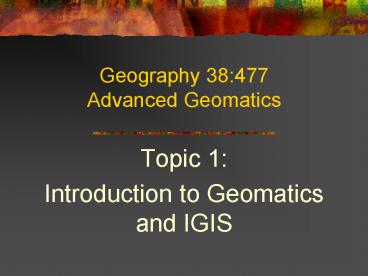Geography 38:477 Advanced Geomatics - PowerPoint PPT Presentation
1 / 15
Title:
Geography 38:477 Advanced Geomatics
Description:
What is a Geomatics? Geomatics is the science and technology of gathering, ... Jerome Dobson 1993 A conceptual framework for integrating remote sensing, GIS, ... – PowerPoint PPT presentation
Number of Views:80
Avg rating:3.0/5.0
Title: Geography 38:477 Advanced Geomatics
1
Geography 38477Advanced Geomatics
- Topic 1
- Introduction to Geomatics and IGIS
2
What is a Geomatics?
- Geomatics is the science and technology of
gathering, analyzing, interpreting, distributing
and using geographic information - Geomatics includes
- surveying
- mapping
- remote sensing (RS)
- geographic information systems (GIS)
- the global positioning system (GPS)
3
What is a Geomatics?
- Surveying
- measurement of
- distances
- directions
- elevations
- angles
- for determining absolute or relative location of
features
4
What is a Geomatics?
- Mapping
- creation of a real or virtual map through the
processes of - data collection
- design
- and production
- in accordance with cartographic theory and
practice (i.e. the rules of map making)
5
What is a Geomatics?
- Remote Sensing
- the science and art of obtaining information
about an object or phenomenon - through the analysis of data collected by
instruments or sensors - not in direct contact with the feature in
question
6
What is a Geomatics?
- GIS
- an information system consisting of
- hardware, software, spatial data,
personnel,organizational and institutional
arrangements - used for the
- management, integration, storage, retrieval,
creation, manipulation, analysis, and display - of spatial information
7
What is a Geomatics?
- GPS
- a satellite-based positioning/navigation system
- consisting of
- a constellation of satellites
- network of ground control stations
- and relatively inexpensive receiver
- used for determining absolute location through
the principles of triangulation (satellite
ranging)
8
Integrated GIS (IGIS)
- GIS in which some degree of integration between
various geomatics technologies has occurred - Advantage is ease with which current (i.e. recent
or real time), accurate, and reliable data can be
provided to the GIS - The duration, methods and degree of integration
vary considerably
9
Conceptual Framework for IGIS
- Jerome Dobson 1993 A conceptual framework for
integrating remote sensing, GIS, and geography
PERS 59 (10), 1491-1496 - Focus on integration of RS
- Seamless integration of RS data
- Raster vector integration
- But not just technological integration
- Tradition of landscape analysis as a conceptual
model for integration and application of IGIS
10
Models of Integration
- Jay Gao 2002 Integration of GPS with remote
sensing and GIS reality and prospect PERS
68(5), 447453 - Focus on integration of RS, GPS and GIS
- Four different models of integration
11
Linear Model
- Interaction is linear and unidirectional
- GPS -gt RS -gt GIS
- GPS coordinates for orthorectification of RS
- RS data classified to extract land cover features
- RS data imported to GIS
- Integration occurs in separate, isolated stages
- GPS used to facilitate integration of RS data
- No connection between GPS and GIS
- GIS dominant role, GPS and RS provide data
12
Interactive Model
- Same as linear but linkages flow is both
directions - GPS for orthorectification, field mapping, and
training field selection, accuracy assessment - RS data imported to GIS, used as ancillary data
to improve or facilitate classification - Limited interaction between GPS and GIS
- RS or GIS component may play dominant role
13
Hierarchical Model
- Two tiers of integration, unidirectional flow
- First involves GPS and RS components and possible
a map overlay type operation - Second level of integration involves development
of a model based on the established relationship
that is executed either within the RS or GIS
component. - GPS plays more substantial role, GIS may or may
not be an integral component
14
Complex Model
- Linkages occur between all three components in
both directions - GPS linked to GIS to update/maintain database
- GIS linked to GPS for navigation, monitoring,
assessment, and database management - Real-time data acquisition
15
Integration Model
- Several variations of four basic models exist
- Current trend toward fully integrated model
- Geospatial database may become a separate
component with linkages between it and the three
primary geomatics technologies































